Imagine this: you’re standing with a gelato in one hand and a slice of apple pie in the other, wondering how Italy and the USA, two seemingly different worlds, compare. Well, you’re in luck because we’re about to embark on a delightful journey exploring the 10 massive differences between Italy and the USA that are guaranteed to make you smile 🙂
Culturally rich Italy, the land of ‘la dolce vita’, ancient ruins, and unbeatable cuisine, often feels worlds apart from the vast, innovation-driven landscape of the USA, known for its dazzling cities, diverse landscapes, and, yes, fast food taken to an art form. It’s like comparing spaghetti to hot dogs, Michelangelo to Andy Warhol, but as we dive into these differences, you’ll see it’s exactly these contrasts that make the comparison fascinating and heartwarmingly amusing.
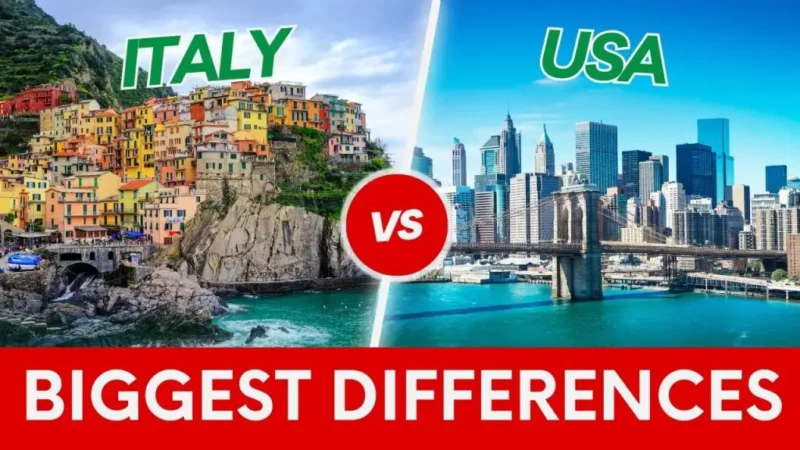
From how we take our coffee to the way we work, and play, Italy and the USA couldn’t be more different if they tried, and yet, there’s a curious charm in examining these distinctions. So, let’s chuckle together at these quirky disparities and maybe, just maybe, we’ll find that these differences aren’t just about countries, but about the colorful palette of human experiences across our beautiful planet.
10 Massive Differences Between The US And Italy
1. Coffee Culture: The Italian Espresso Ritual vs. The American Coffee Odyssey
In Italy, coffee is less a drink and more a cornerstone of culture. Entering an Italian café, you’re met with the aroma of freshly ground espresso beans, a scent as integral to the country as its art.
Coffee here is a ritual, a momentary pause in the day, consumed quickly while standing, akin to a spiritual communion with the bean. The Italian espresso is a concentrated burst of joy, requiring just a few sips to achieve caffeinated enlightenment.
This reverence for the quality and essence of coffee contrasts starkly with the American approach. In the U.S., coffee is the fuel that powers the ever-busy lifestyle. Coffee shops serve gargantuan vessels of brew that one could swim in, often adulterated with a dizzying array of syrups, whipped cream, and flavors that can make the coffee itself an afterthought.
It’s a testament to the American ethos of bigger and bolder, a sprawling coffee odyssey versus the Italian espresso’s focused pilgrimage.
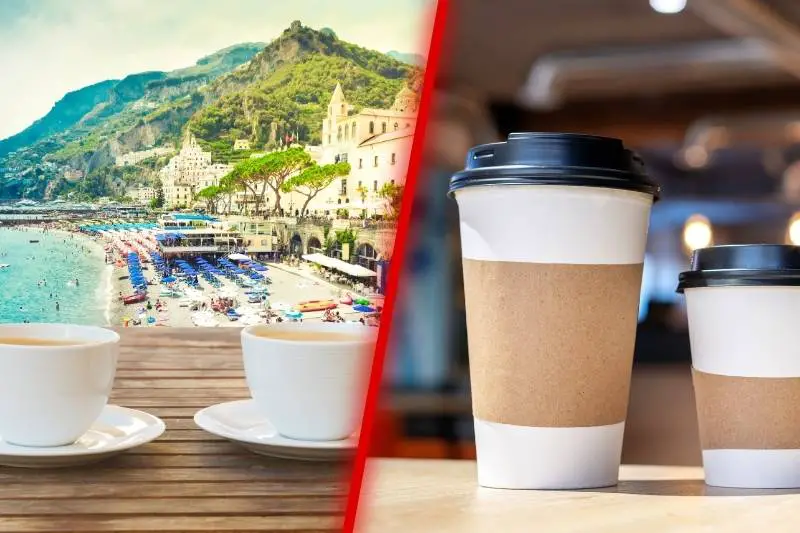
2. Meal Times: America’s Early Bird Dinners vs. Italy’s Nocturnal Feasts
The timing of meals in the U.S. could easily perplex an Italian visitor. Dinner between 6 and 7pm is standard, fitting neatly into the early-to-rise, early-to-bed lifestyle many Americans adhere to. This dining schedule aligns with a broader cultural impetus towards maximizing daylight hours for productivity and leisure alike.
Contrastingly, Italy’s dinner time is an event that unfolds under the stars. An 8pm start is considered early, with meals often stretching well into the night. This isn’t merely a reflection of a different approach to scheduling but a deeply ingrained sociocultural ritual where food, family, and friends converge in a leisurely celebration of life.
Dinner in Italy is more than sustenance; it’s a nightly festival of flavors, conversations, and connections, a stark departure from the American efficiency-driven mealtime.
3. Bread Etiquette: Buttered Slices vs. Olive Oil Dips
Americans and Italians both love their bread, but the way they bring it to life on the dining table couldn’t be more different. In the U.S., bread is often a prelude to the main meal, served warm with butter that melts into its crevices, a comforting start to any dining experience.
This practice stems from America’s abundant butter production and a general penchant for heartier, comforting food.
Meanwhile, Italy offers its bread with a side of olive oil, turning each slice into a canvas for the country’s liquid gold. This tradition not only showcases the Italian pride in their olive oil’s quality but also reflects a broader Mediterranean diet, known for its health benefits and simplicity.
Dipping bread into olive oil in Italy is more than a culinary practice; it’s a gesture of embracing a millennia-old heritage that honors the olive tree’s bounty.

4. Tipping Culture: The American Calculus vs. The Italian Gesture
In America, tipping is an embedded social custom, a complex dance of percentages where the amount left often feels like a reflection of one’s character. The practice is so ingrained that not tipping can result in social stigma or in the worst cases, viral public shaming.
This system reflects the U.S.’s service-oriented economy and the value placed on customer service, but it can also add a layer of stress to the dining experience as patrons navigate the expectations of gratuity mathematically.
In Italy, the landscape of tipping couldn’t be more relaxed. Service is typically included in the form of a coperto (cover charge), and any additional tip is seen as a heartfelt thank you for exceptional service, not an obligatory part of the dining ritual. This approach mirrors the Italian emphasis on hospitality as an inherent part of life’s pleasures, not a service to be quantified.
5. Fashion Philosophy: America’s Comfort Quest vs. Italy’s Style Symphony
The American wardrobe is a testament to the country’s pioneering spirit, prioritizing comfort, practicality, and versatility above all. This can manifest in the universal acceptance of jeans and sneakers as appropriate attire for almost any occasion, celebrating the freedom to express oneself and the dynamism of American life.
On the other side of the Atlantic, Italy’s sartorial approach is akin to a carefully composed symphony, where every piece of clothing plays its part in creating a harmonious ensemble. Italian fashion exudes a sense of effortless elegance, with a keen eye for detail, silhouette, and quality that reflects centuries of craftsmanship and an intrinsic national pride in looking one’s best.
The Italian saying “la bella figura” (making a good impression) encapsulates this philosophy, where dressing well is seen as a form of respect for oneself and others, a cultural ethos intertwined with Italy’s world-renowned design heritage.
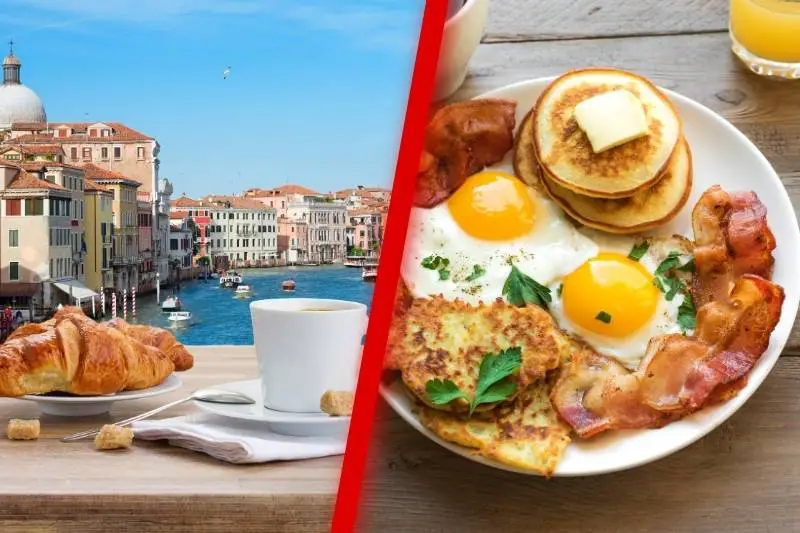
6. Breakfast Choices: America’s Hearty Start vs. Italy’s Sweet Awakening
In the U.S., breakfast is a meal that champions the philosophy of starting your day with a hearty foundation. American breakfast tables are often laden with a smorgasbord of eggs, bacon, pancakes, and waffles, doused with syrup and served with sides of potatoes and toast. This approach not only caters to the ethos of abundance and variety but also prepares one for the day ahead with a burst of energy.
In contrast, Italy greets the morning with a touch of sweetness and simplicity. A typical Italian breakfast consists of a cappuccino paired with a cornetto (croissant) or other pastries, a light but energizing start to the day.
This difference illuminates the Italian preference for lingering over coffee and conversation in the morning, savoring the tranquility of dawn rather than diving headfirst into the day’s demands.
7. Urban Navigation: The American Grid vs. Italy’s Ancient Labyrinths
American cities, with their youth compared to their European counterparts, often boast a straightforward grid layout, a reflection of the Enlightenment-era emphasis on order and reason. This planned regularity makes navigation a breeze, with streets numbered and organized in a logical sequence.
Italy’s urban landscapes, sculpted by the hands of time, unfold as intricate labyrinths that echo the complex layers of history they’re built upon. Navigating an Italian city is like walking through a living museum, where every turn reveals centuries-old stories etched into the architecture.
This juxtaposition highlights not just differing urban planning philosophies but also the contrasting historical trajectories that have shaped the identity and rhythm of life in American and Italian cities.
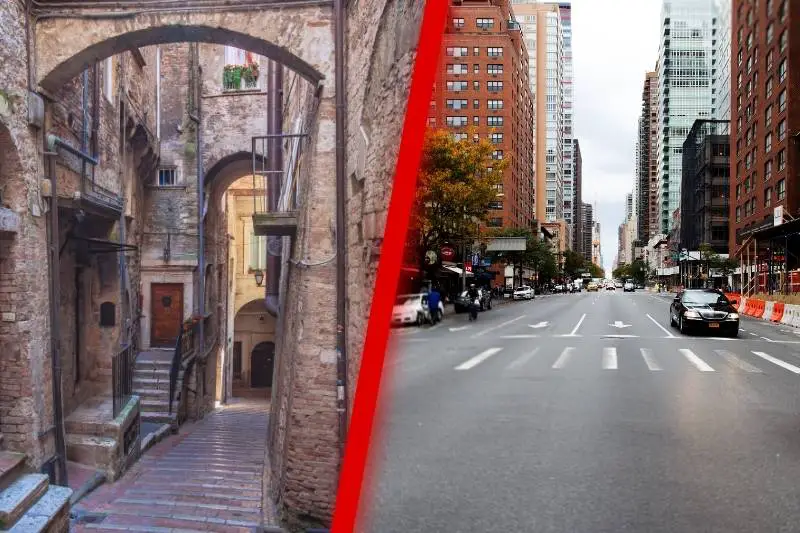
8. Siesta vs. Non-stop Hustle: Embracing the Riposo
The U.S. is a nation celebrated for its relentless hustle, where the concept of a midday break seems almost alien. The 24/7 availability of goods and services mirrors the American dedication to convenience, productivity, and the pursuit of success.
Meanwhile, Italy treasures its riposo, a sacred pause in the afternoon where businesses close, and cities seem to take a collective breath. This time-honored tradition encourages a moment of rest, a leisurely lunch, or time spent with family, reflecting a broader cultural prioritization of well-being, social ties, and life’s pleasures over unending work.
This difference underscores a fundamental divergence in life philosophy – the American dream’s ceaseless push for more versus the Italian embrace of la dolce vita, savoring the sweetness of life in every moment.
9. Life’s Tempo: The American Sprint vs. The Italian Stroll
In the U.S., time feels like a commodity that is always in short supply, leading to a fast-paced lifestyle where multitasking and constant activity are badges of honor. This permeates every aspect of American life, from fast food to express lanes, underscoring an ethos where efficiency and speed are paramount.
Contrast this with Italy, where the tempo of life seems to follow the leisurely pace of a countryside stroll. Meals are lingered over, conversations are savored, and the concept of hurry is often reserved for emergencies. This speaks to the Italian emphasis on the quality of life and the belief that the best moments unfold in their own time, a philosophy that encourages living fully in the present, immersing oneself in the richness of now.
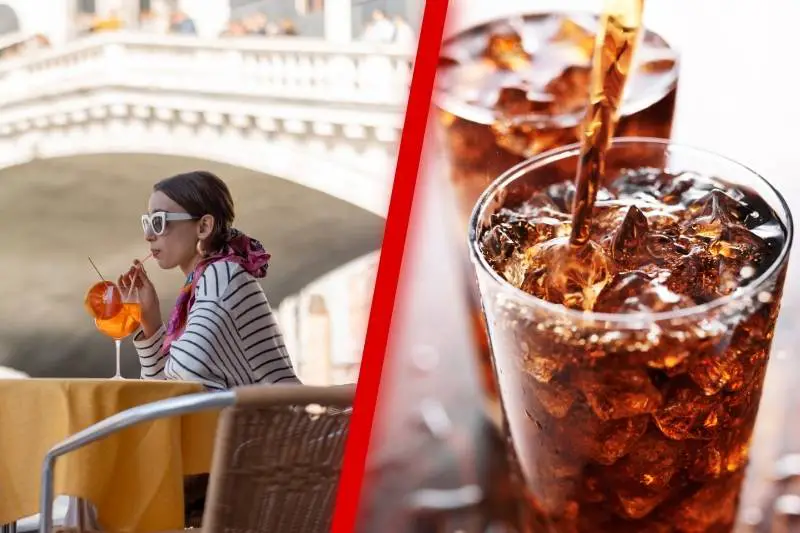
10. Ice: America’s Cold Embrace vs. Italy’s Chilly Reception
In America, ice is liberally used in beverages, creating refreshingly cold drinks that battle the heat with gusto. This abundance of ice speaks to the American love for extremes and super-sized interpretations of everything, including the temperature of their drinks.
On the opposite spectrum, Italy’s relationship with ice in beverages is one of cautious moderation. Ice is often used sparingly, if at all, guided by the belief that too much cold can shock the system and dilute the essence of the drink.
This nuanced approach reflects a broader culinary philosophy that values the integrity and flavor of ingredients, whether in a dish or a simple glass of water. It encapsulates the cultural divide in how comfort, health, and pleasure are balanced in the everyday rituals that define life on either side of the Atlantic.
In exploring the myriad differences between the United States and Italy, from the serenading morning cappuccinos in bustling Italian piazzas to the grand, sprawling landscapes and dynamic cities of the U.S., we uncover more than just cultural distinctions—we discover the joy of diversity. These contrasts, illustrated with a light-hearted touch, serve not only to entertain but to enrich our understanding and appreciation of what makes each place uniquely captivating.
Embracing these nuances can make us smile, reminding us that despite our diverse backgrounds, we’re all connected in our ability to find joy in the unexpected.
Learn more about how Italians live in our story here that shatters all stereotypes. You can also learn how to live la dolce vita here. Find all our latest stories about Italy here.
